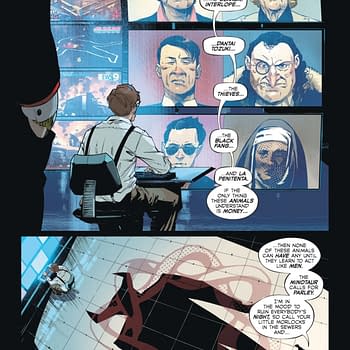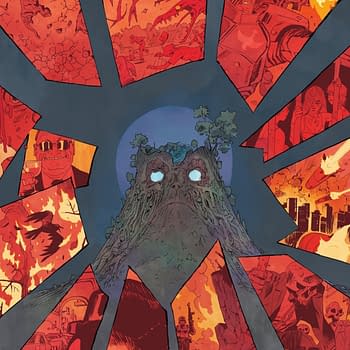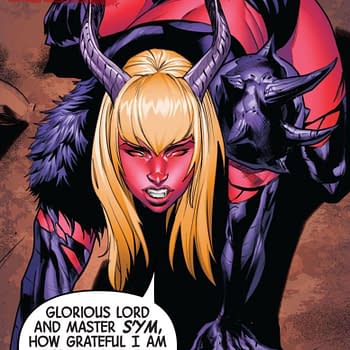Posted in: Comics, Recent Updates | Tagged: billy dogma, Christa Cassano, Comics, dark horse comics, dean haspiel, entertainment, George Folz, Gregory Benton, idw, joe infurnari, oni press, Seth Kushner, the bunker, Vito Delsante
Hanging At Hang Dai Studios With Joe Infurnari, Dean Haspiel, And Seth Kushner
Walking into an active comics studio is always an experience in discovering the Kevin-Bacon like limited series of "degrees of separation" between the comics that are being produced right now. There are usually arcane connections that lead between books that no one's the wiser to unless they happen to stand in the room at the right time. Hang Dai Studios, one of several functioning studios in the Gowanus warehouse building under an always under construction railroad bridge in Brooklyn always generates that experience for me. How many people would think there are connections between Archie's Dark Circle line, Oni Press' The Bunker, a MoCCA Fest award winning book, and an upcoming biographical graphic novel about John Leguizamo? Throw Action Lab books and plenty of indie publications into the mix and you're beginning to sketch out the things that come out of Hang Dai.
I knew that since my last visit, The Bunker's Joe Infurnari had joined the studio, which is a large-windowed street-facing room on an upper floor, and it seems like the room is always being reconfigured to fit more desks of varying types and witnessing a degree of turnover as people move, take jobs that are too far to commute, or decide to work from home for awhile. On a Friday afternoon, with a building Christmas party looming at a cozy nearby bar, things were still getting done at quite a pace. Infurnari was drawing Issue #9 of The Bunker, Dean Haspiel was putting the finishing touches on a pin-up for The Hip Hop Family Tree Volume 3, and Vito Delsante of the recently Action Lab addition Stray (previously a successful Kickstarter) was tapping away.

Later they were joined by Christa Cassano (contributor to the anthology Schmuck, frequent tabler at indie shows, and artist on the aforementioned Leguizamo book Ghetto Klown which she's adapting into a graphic novel for Abrams). Not to undermine his portrait as an incredibly hard-working man, but B+F's Gregory Benton (from Ad House Books, and a book that was the most massive thing on the market until Little Nemo: Dream Another Dream hit shops), took down his acoustic guitar from the wall and started strumming, precipitating a discussion of what cover songs were being requested and whether they were up to snuff for his attentions. The unseen but nevertheless atmospherically present member of the studio, and one of its founding members, was Seth Kushner, award-winning photographer and comics writer currently in the hospital fighting Leukemia, but a phone call later in the afternoon brought him even closer to his creative home.
I've known most of these folks since my first steps into comics journalism writing for Trip City (of which Dean Haspiel and Seth Kushner were co-founders), and then for The Beat before my Bleeding Cool role began, and I've witnessed the vicissitudes of their lives as freelancers, the woes and joys endemic to it, and also tracked some of the changes in their styles and projects over time. Having said that, visiting them at work always reveals a half dozen or so areas of activity that I wasn't aware of, part of the benefit of a studio visit to see what's actually on the desk for each.
Joe Infurnari, whose self-published sci-fi time-twisting story The Bunker with Joshua Hale Fialkov was picked up for a TV option even before the comic landed at Oni Press has been a very busy man, both drawing and coloring, and for the most part lettering the ongoing series. He's currently drawing the 9th issue, with #8 coming out this week. He kindly walked me through the steps and layers of his process on his swivel-armed large tablet and explained that Issue #9 is the "closer" to the second arc of the series, and will be the final installment in the second trade collection. The digital layers I was privy to included blue-lined roughs, then pencil roughs, then a more enhanced "ink" look, though traditional inking isn't involved.
Infurnari actually letters the comic in a very early phase, then hands in the layout version to Fialkov and his editor, presenting a version to them that's so developed that they can "basically read the comic" at first pass. Part of the motivation for doing so is personal. Putting the letters in early gives him a sense that "it's a comic now" and energizes him for the work ahead. Another reason he letters the comic early is to help him decide what the "first thing" he wants the reader to look at in a panel is, since he sees the comic as a "crude animation" in his "head" and it helps him "parse out information for the flow of the story".
As to why Infurnari composes digitally, he's an early proponent of webcomics, but nevertheless has produced several graphic novels on "paper" previously. After his last project on paper, Marathon from First Second, he realized he needed a more practical mode of working quickly on schedule and finds that digital composition allows for limitless erasure of lines and changes that simply trump a paper method. To demonstrate, he zoomed into a very detailed panel on his tablet and added a feature that would be tiny to the human eye, some graffitti, zoomed out again to show it's location, then zoomed in again and removed it. For those familiar with Infurnari's many-lined, sketchy style, replete with emotive linework, this makes perfect sense. He's a man who lays down many more lines than a majority of comic artists, and yet is very specific in doing so. Thankfully, digital tools have helped him streamline his process while providing a powerful effect on the page.


Haspiel had completed that work, but was delving into the detail needed on another pin-up, one for Ed Piskor's Hip Hop Family Tree Vol. 3, which connected to his own history with hip-hop. His piece, entitled Mantronix, pays homage to a musician who helped form "electro-funk" in the 80s and introduced him to "early electronica". In typical Haspiel speak, he explained that the music, which he played for me, "sounds like robots fucking to me". I can't say I quite heard that element, but I could certainly see where he was coming from. You can see the finished version here and learn more about the project.



























